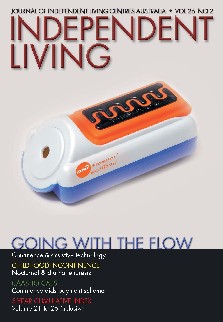
Publications
Independent LivingVolume 26 No 2
published in July 2010
Featured Articles
Going with the Flow
- Continence and Assistive TechnologyBy Rosalie Donhardt, Dept Families & Communities SA
Incontinence is a significant health issue affecting over 3.8 million Australians.
It may affect people of all ages and may be linked with other health issues, such as diabetes, obesity, arthritis, dementia or disability.
Assessment by a health professional is the initial key point to management of incontinence as there are many possible causes for both urinary and faecal incontinence and many treatment options available.
CAAS to CAPS
- Continence Aids Payment SchemeThe Essential Information.
From 1 July 2010 the Continence Aids Assistance Scheme (CAAS) will be replaces by the Continence Aids Payment Scheme (CAPS).
Incontinence in Australia
- Facts & Figuresby Marilyn Woodcock, Continence Foundation of Australia
Childhood Incontinence
- Nocturnal & Diurnal Enuresisby Gail Nankivell, Senior Physiotherapist, The Children’s Hospital at Westmead
Patrina H.Y. Caldwell, Senior Lecturer, Paediatrics and Child Health, University of Sydney
Incontinence (daytime wetting) and nocturnal enuresis (bedwetting) in childhood and adolescence can have a significant impact on self esteem, relationships (peer and parental), school performance and later sexual activity.
Nocturnal enuresis can also affect cognitive performance but has been shown to improve with treatment.(2) Assuming a child will grow out of it is not necessarily an acceptable option.
With early assistance in correct diagnosis and appropriate management, much of the distress that surrounds this condition can be avoided.
